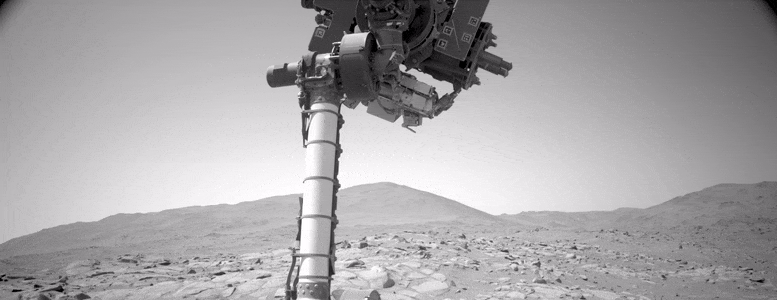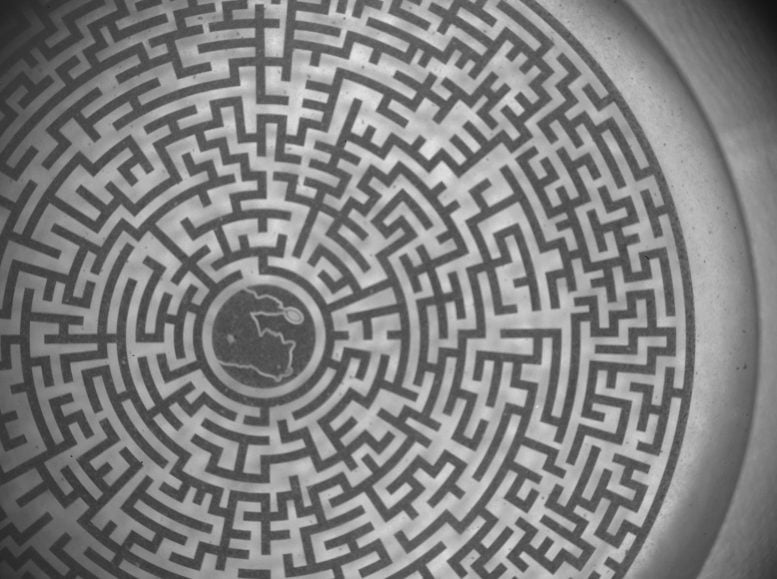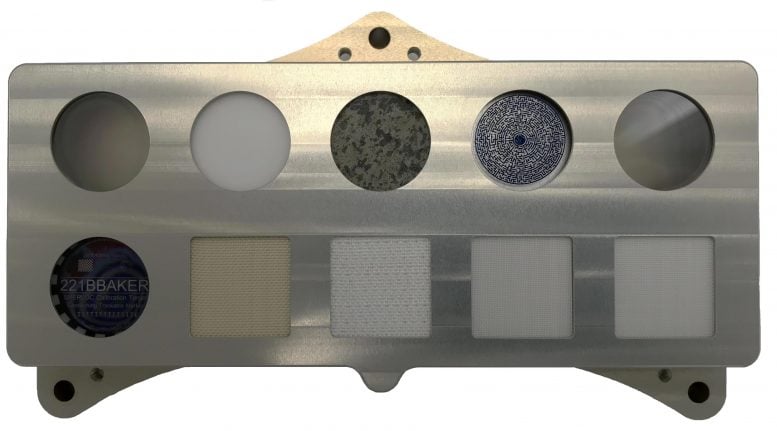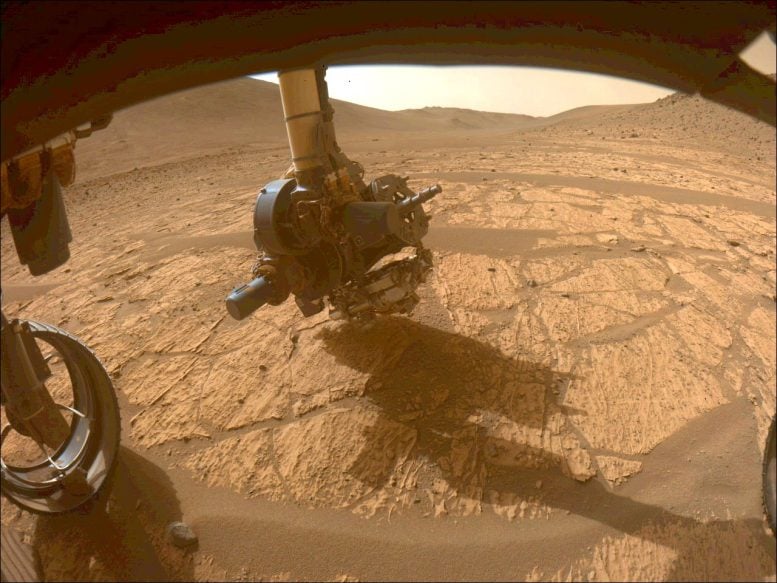As seen in this artist’s concept, the SHERLOC instrument sits atop the robotic arm of NASA’s Perseverance Mars rover. Credit: NASA/JPL-Caltech
After six months of effort, a tool that helps NASAPerseverance Mars A rover searching for potential signs of ancient microbial life is back online.
After a mechanical failure halted SHERLOC operations on the Perseverance rover, NASA engineers performed extensive testing and innovative repairs to restore the instrument. Their efforts, which involved manipulating the rover’s components to free a jammed lens cover, enabled continued exploration and data collection on Mars, focusing on geological signs of ancient life.
The SHERLOC (Scanning Habitable Environments with Raman & Luminescence for Organics and Chemicals) instrument aboard NASA’s Perseverance Mars rover analyzed a rocky target with its spectrometer and camera for the first time since encountering the problem in January this year. This instrument plays a key role in the search for signs of ancient microbial life on Mars. Engineers at NASA’s Jet Propulsion Laboratory (JPL) in Southern California confirmed on June 17 that the instrument had succeeded in collecting data.
“Six months of running diagnostics, testing, image and data analysis, troubleshooting and retesting couldn’t have produced a better conclusion,” said SHERLOC Principal Investigator Kevin Hand of JPL.

Images captured by the navigation camera aboard NASA’s Perseverance rover on Jan. 23 show the location of the shroud on the SHERLOC instrument. The cover got stuck a few weeks ago, but the rover team has since found a way to fix the problem so the instrument can continue to operate. Credit: NASA/JPL-Caltech
Mounted on the rover’s robotic arm, SHERLOC uses two cameras and a laser spectrometer to search for organic compounds and minerals in rocks that have been altered in an aquatic environment and can reveal signs of past microbial life. On January 6, a movable lens hood designed to protect the instrument’s spectrometer and one of its cameras from dust froze in a position that prevented SHERLOC from collecting data.
Analysis by the SHERLOC team pointed to a failure of the small motor responsible for moving the lens hood as well as adjusting the focus for the spectrometer and the Autofocus and Context Imager (ACI) camera. Testing potential solutions on the SHERLOC duplicate at JPL, the team began a long and painstaking evaluation process to determine if and how the lens hood could be moved to the open position.

The housing for the Autofocus and Context Imager on SHERLOC — one of the instruments aboard NASA’s Perseverance Mars probe — is seen moving in images taken by the rover’s Mastcam-Z instrument on May 11. Acknowledgments: NASA/JPL-Caltech/ASU/MSSS
SHERLOC Tracking
Among many other steps, the team experimented with heating a small lens hood motor, commanding the rover’s robotic arm to rotate the SHERLOC instrument in various orientations using supporting Mastcam-Z images, rocking the mechanism back and forth to dislodge any debris that might block the lens. cover, and even engage the rover’s percussive drill to try to loosen it. On March 3, images returned from Perseverance showed that the ACI cover had opened more than 180 degrees, clearing the imager’s field of view and allowing the ACI to be positioned close to the target.

The Perseverance team used the SHERLOC instrument’s Autofocus and Context Imager to capture this image of their calibration target on May 11 to confirm that the stuck lens hood problem had been resolved. In the center of the target is the silhouette of the fictional detective Sherlock Holmes. Credit: NASA/JPL-Caltech
“With the cover out of the way, a line of sight was established for the spectrometer and camera. We were halfway there,” said Kyle Uckert, deputy principal investigator of SHERLOC at JPL. “We still needed a way to focus the tool on the target. Without focus, the SHERLOC images would be blurry and the spectral signal weak.”
Like any good ophthalmologist, the team set out to find a prescription for SHERLOC. Unable to adjust the focus of the instrument’s optics, they relied on the rover’s robotic arm to make small adjustments to the distance between SHERLOC and its target to achieve the best image resolution. SHERLOC was ordered to take images of its calibration target so the team could check the effectiveness of this approach.

The calibration target for SHERLOC, one of the instruments aboard NASA’s Perseverance Mars rover, contains a piece of a Martian meteorite plus spacesuit materials, including helmet visor material that serves as a geocache target. Credit: NASA/JPL-Caltech
“Rover’s hand is amazing. It can be controlled in small, quarter-millimeter increments to help us evaluate the new SHERLOC focus position, and it can position the SHERLOC with a high accuracy on target,” Uckert said. “After testing first on Earth and then on Mars, we found that the best distance to place the SHERLOC robotic arm is about 40 millimeters,” or 1.58 inches. “At that distance, the data we’re collecting should be as good as it’s ever been.”
Confirmation of ACI’s correct location on the Martian rock target came on 20 May. Verification on June 17 that the spectrometer was also functional checked the team’s last box, confirming that SHERLOC was functional.

This image of NASA’s Perseverance rover collecting data on the “Walhalla Glades” abrasion was taken in the “Bright Angel” area of Crater Lake by one of the rover’s forward hazard avoidance cameras on June 14. The WATSON camera on the SHERLOC instrument is the closest to the Martian surface. Credit: NASA/JPL-Caltech
“Mars is hard, and bringing instruments back from the edge is even harder,” said JPL’s Perseverance Project Manager Art Thompson. “But the team never gave up. With SHERLOC back online, we continue to survey and collect samples with a full complement of scientific instruments.”
Perseverance is in the later stages of its fourth science campaign, looking for evidence of carbonate and olivine deposits in the “Margin Unit,” an area along the inner rim of Lake Crater. On Earth, carbonates typically form in the shallows of freshwater or alkaline lakes. It is thought that this could also be the case for the Margin unit, which formed more than 3 billion years ago.
Mars 2020 endurance mission
Launched by NASA, the Mars 2020 Perseverance mission is part of the agency’s Mars Exploration Program. Its primary goal is to search for signs of ancient life and collect rock and regolith (broken rock and soil) samples for eventual return to Earth.
The Perseverance rover landed on Mars on February 18, 2021 in Jezero Crater, a site believed to have been the basin of an ancient river delta. The mission also pioneers the technology needed for future human and robotic exploration of Mars. Key goals include studying Martian climate and geology, searching for signs of ancient life, collecting samples of Mars, and preparing for human exploration. In addition to its scientific instruments, Perseverance carries the Ingenuity helicopter, which is performing powered flight on another planet for the first time.